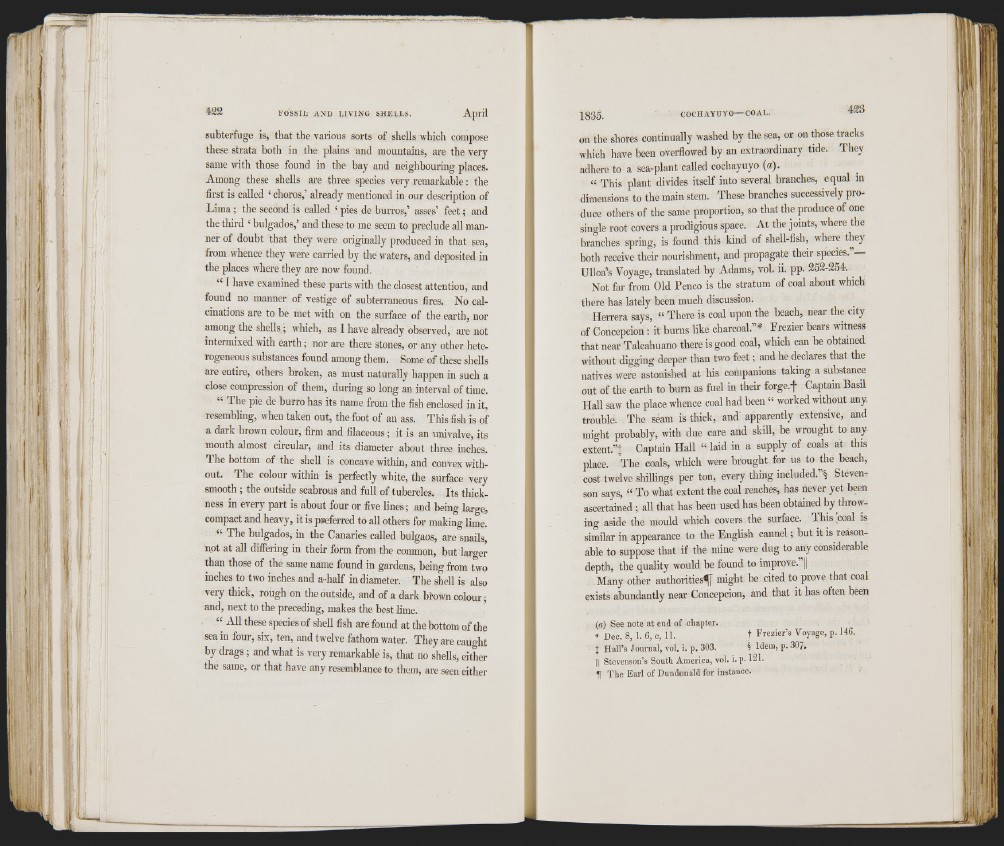
Il:
S' H
» *
! ,
'i ■
i
>I Ii,
IIILI'
. f ( '
' :
0 il i
M i il
:: |il :
I
r î I
, Il
fj . ' -a: ,
April
subterfuge is, that the various sorts of shells which compose
these strata both in the plains and mountains, are the very-
same with those found in the bay and neighbouring places.
Among these shells are three species very remarkable; the
first is called ‘ choros,’ already mentioned in our description of
Lima ; the second is called ‘ pies de burros,’ asses’ feet; and
the third ‘ bulgados,’ and these to me seem to preclude all manner
of doubt that they were originally produced in that sea,
from whence they were carried by the waters, and deposited in
the places where they are now found.
“ I have examined these parts with the closest attention, and
found no manner of vestige of subterraneous fires. No calcinations
ai-e to be met with on the surface of the earth, nor
among the shells; which, as I have already observed, are not
intermixed with earth; nor are there stones, or any other heterogeneous
substances found among them. Some of these shells
are entire, others broken, as must naturally happen in such a
close compression of them, during so long an interval of time.
“ The pie de burro has its name from the fish enclosed in it,
resembling, when taken out, the foot of an ass. This fish is of
a dark brown colour, firm and filaceous ; it is an univalve, its
mouth almost circular, and its diameter about three inches.
The bottom of the shell is concave within, and convex without.
The colour within is perfectly white, the surface very
smooth ; the outside scabrous and full of tubercles. Its thickness
in every part is about four or five lines; and being large,
compact and heavy, it is preferred to all others for making lime.
“ The bulgados, in the Canaries called bulgaos, are snails,
not at all differing in their form from the common, but larger
than those of the same name found in gardens, being from two
inches to two inches and a-half in diameter. The shell is also
very thick, rough on the outside, and of a dark brown colour;
and, next to the preceding, makes the best lime.
“ All these species of shell fish are found at the bottom of the
sea in four, six, ten, and twelve fathom water. They are caught
by drags ; and what is very remarkable is, that no shells, either
the same, or that have any resemblance to them, are seen either
on the shores continually washed by the sea, or on those tracks
which have heen overflowed by an extraordinary tide. They
adhere to a sea-plant called cochayuyo (a).
“ This plant divides itself into several branches, equal in
dimensions to the main stem. These branches successively produce
others of the same proportion, so that the produce of one
single root covers a prodigious space. At the joints, where the
branches spring, is found this kind of shell-fish, where they
both receive their nourishment, and propagate their species.
Ulloa’s Voyage, translated by Adams, vol. ii. pp. 252-254.
Not far from Old Penco is the stratum of coal about which
there has lately been much discussion.
Herrera says, “ There is coal upon the beach, near the city
of Concepcion ; it burns like charcoal.”* Frezier bears witness
that near Talcahuano there is good coal, which can he obtained
without digging deeper than two feet ; and he declares that the
natives were astonished at Ills companions taking a substance
out of the earth to burn as fuel in their forge.f Captain Basil
Hall saw the place whence coal had been “ worked without any
trouble. The seam is thick, and apparently extensive, and
might probably, with due care and skill, be wrought to any
extent.”] Captain Hall “ laid in a supply of coals at this
place. The coals, which were brought for us to the beach,
cost twelve shillings per ton, every thing included.”^ Stevenson
says, “ To what extent the coal reaches, has never yet been
ascertained ; all that has heen used has been obtained by throwing
aside the mould which covers the surface. This coal is
similar in appearance to the Lnglish cannel ; but it is reasonable
to suppose that if the mine were dug to any considerable
depth, the quality would he found to improve.”!]
Many other authorities^ might be cited to prove that coal
exists abundantly near Concepcion, and that it has often been
(a) See note at end of chapter.
* Deo. 8, 1. 6, c, 11. t Frezier’s Voyage, p. 146.
t Hall’s Journal, vol. i. p. 303. § Idem, p. 307.
11 Stevenson’s South America, vol. i. p* 121.
T[ The Earl of Dundonald for instance.
(I à
, ir-
( I
liiri'"
ii.li